窗口函数练习
窗口函数其实日常中用的是比较多的,加上之前我们分别介绍了各个窗口函数,今天我们就练习和总结一下,从而可以更好的掌握窗口函数
题目
题目一:每个用户截止到每月为止的最大交易金额和该月的累积总交易金额
数据源格式如下
| 表名 | 表注释 | 字段 | 字段注释 | |
|---|---|---|---|---|
| ods_sales_orders | 订单明细表 | sales_order_key | 订单主键 | 一个订单表示销售一个产品 |
| ods_sales_orders | 订单明细表 | create_date | 订单日期 | |
| ods_sales_orders | 订单明细表 | customer_key | 客户编号 | |
| ods_sales_orders | 订单明细表 | product_key | 产品编号 | |
| ods_sales_orders | 订单明细表 | english_product_name | 产品名 | |
| ods_sales_orders | 订单明细表 | cpzl_zw | 产品子类 | |
| ods_sales_orders | 订单明细表 | cplb_zw | 产品类别 | |
| ods_sales_orders | 订单明细表 | unit_price | 产品单价 |
输出结果数据格式如下
| customer_key | umonth(当月) | ucount(月订单量) | current_max(最大交易金额) | current_sum(累计该月总交易金额) |
|---|---|---|---|---|
| 11009 | 2018-12 | 1 | 53.99 | 53.99 |
| 1358999 | 2019-2 | 1 | 28.99 | 28.99 |
| 1358999 | 2019-4 | 1 | 69.99 | 98.98 |
| 1359000 | 2019-1 | 1 | 2294.99 | 2294.99 |
| 1359002 | 2019-11 | 1 | 8.99 | 8.99 |
| 1359003 | 2020-1 | 1 | 1120.49 | 1120.49 |
| 1359005 | 2019-2 | 1 | 782.99 | 782.99 |
| 1359009 | 2019-1 | 1 | 2384.07 | 2384.07 |
| 1359014 | 2019-1 | 1 | 69.99 | 69.99 |
| 1359014 | 2019-2 | 1 | 69.99 | 69.99 |
思路:
- 1.对数据按照客户及其年-月分组
- 2.分组后就每月销售金额之和
- 3.使用窗口函数,对每个客户不同月份分组求最大值(max)和累计值(sum)
解答:
select t.customer_key, t.umonth, t.ucount,
max(current_max) over(partition by t.customer_key order by umonth) as current_max,
sum(current_sum) over(partition by t.customer_key order by umonth) as current_sum
from
(
select
customer_key, substr(create_date,1,7) as umonth,
count(sales_order_key) as ucount,
max(unit_price) as current_max,
sum(unit_price) as current_sum
from
adventure_ods.ods_sales_orders
group by
customer_key, substr(create_date,1,7)
) tpm;
备注:也可以使用with tmp as () 句法:
with tmp as (
select
customer_key, substr(create_date,1,7) as umonth,
count(sales_order_key) as ucount,
max(unit_price) as current_max,
sum(unit_price) as current_sum
from
adventure_ods.ods_sales_orders
group by
customer_key, substr(create_date,1,7)
)
select
customer_key, umonth, ucount,
max(current_max) over(partition by customer_key order by umonth) as current_max,
sum(current_sum) over(partition by customer_key order by umonth) as current_sum
from tmp limit 10;
点评:
上面的写法就是为了窗口函数而窗口函数的,而且还计算错了你看到最后的结果是累积和最大是相等的,问题出在那里了呢,1 这个需求是一个汇总性质的结果,所以我们可以不用使用窗口函数 2 子查询过后每个用户每个月就只有一条数据了
select
customer_key, substr(create_date,1,7) as umonth,
count(sales_order_key) as ucount,
max(unit_price) as current_max,
sum(unit_price) as current_sum
from
adventure_ods.ods_sales_orders
group by
customer_key, substr(create_date,1,7)
这样就可以了
题目二:求用户号对应不同的产品
数据源格式如下
| 用户号 | 产品 | 购买时间 |
|---|---|---|
| 1 | A | 2019-12-23 |
| 1 | B | 2019-12-23 |
| 2 | C | 2019-12-23 |
| 2 | A | 2019-12-24 |
| 2 | B | 2019-12-23 |
create table ods_user_product_log(
userid string,
product string,
ctm string
) row format delimited fields terminated by ',';
LOAD DATA LOCAL INPATH '/Users/liuwenqiang/workspace/hive/ods_user_product_log.txt' OVERWRITE INTO TABLE ods_user_product_log;
要求输出例子:用户号-产品1-产品2(前两个产品)
**例如:**1-A-B (按先后时间顺序,实现相同时不限定顺序)
思路:
- 1.利用窗口函数,对用户号分组,按时间对产品进行排序
- 2.利用左连或其他方法拼接,然后进行筛选
- 3.用concat或者其他函数拼接获得结果
select
userid,product,row_number() over (partition by userid order by ctm) as rn
from
ods_user_product_log
;

接下来我们可以使用自关联来获取下一个使用的产品,因为是自关联所以我们可以使用with as 的写法
with tmp as (
select
userid,product,row_number() over (partition by userid order by ctm) as rn
from
ods_user_product_log
)
select
a.userid,a.product,b.product
from
tmp a
inner join
tmp b
on
a.userid=b.userid
where
a.rn=1
and b.rn=2
;

接下来你只要使用concat_ws 就可以了
其实前面我们说的 lead,lag 在很多场合下可以替代自关联,接下来我们看看怎么使用lead来完成上面的需求
select concat_ws('-', a.userid, a.product, a.next_product)
from (
select a.userid,
a.product,
lead(product, 1) over (partition by userid order by ctm) as next_product
from ods_user_product_log a
) a
where next_product is not null
;

上面的结果还是需要再处理一步
但是需要注意的是, lead,lag 虽好,但是就上面这个例子,如果我要计算的不是前两个产品,而是全部产品,那你就要使用自关联了
题目三:查询5月份购买过的顾客及总人数
其实我们看到这个题目就是一个普通的聚合操作,因为这里是顾客明细,不是购买明细
select
a.customer_key,count(customer_key)
from
ods_sales_orders a
where
month(create_date)='05'
group by
a.customer_key
;
当然如果你是在想用窗口实现也不是不可以
select
customer_key,
count(*) over()
from
ods_sales_orders
where
month(create_date)="05"
group by
customer_key
;
题目四:查询顾客的购买明细及月购买总额
这才是一个非常典型的窗口函数应用,明细和汇总数据都需要的场景
select
* ,
sum(unit_price) over(partition by customer_key,substr(create_date,1,7))
from
ods_sales_orders
;
题目五:查询顾客的购买明细及当月累积购买总额和月购买总额
select
* ,
sum(unit_price) over(partition by customer_key,substr(create_date,1,7) sort by create_date rows between unbounded preceding and current row ) as sumcost
from
ods_sales_orders
题目六:查询顾客上次的购买时间
提示:使用偏移的窗口函数lag()
select
* ,
lag(create_date,1) over(partition by customer_key sort by create_date) as last_time
from
ods_sales_orders
题目七:查询最近前20%时间的订单信息
提示:使用ntile(x):分割x份。x是整数。
用ntile函数将订单时间按顺序分为5堆
select * from (
select
*,
ntile(5) over(sort by create_date asc) as five_num
from
ods_sales_orders
) t
where
five_num = 1
总结
窗口函数应用场景
(1)用于分区排序
(2)动态Group By
(3)Top N
(4)累计计算
(5)层次查询
常见的窗口函数
汇总函数:
- sum(col) over() : 分组对col求和,over() 中的语法如下
- count(col) over() : 分组对col求个数,over() 中的语法如下
- min(col) over() : 分组对col求最小值
- max(col) over() : 分组求col的最大值
- avg(col) over() : 分组求col列的平均值
获取特定记录函数:
- first_value(col) over() : 某分区排序后的第一个col值
- last_value(col) over() : 某分区排序后的最后一个col值
- lag(col,n,DEFAULT) : 统计往前n行的col值,n可选,默认为1,DEFAULT当往上第n行为NULL时候,取默认值,如不指定,则为NULL
- lead(col,n,DEFAULT) : 统计往后n行的col值,n可选,默认为1,DEFAULT当往下第n行为NULL时候,取默认值,如不指定,则为NULL
分片函数:
- ntile(n) : 用于将分组数据按照顺序切分成n片,返回当前切片值。注意:n必须为int类型。
排名函数:
- row_number() over() : 排名函数,不会重复,适合于生成主键或者不并列排名
- rank() over() : 排名函数,有并列名次,名次不连续。如:1,1,3
- dense_rank() over() : 排名函数,有并列名次,名次连续。如:1,1,2
计算百分比函数:
- cume_dist
- percent_rank